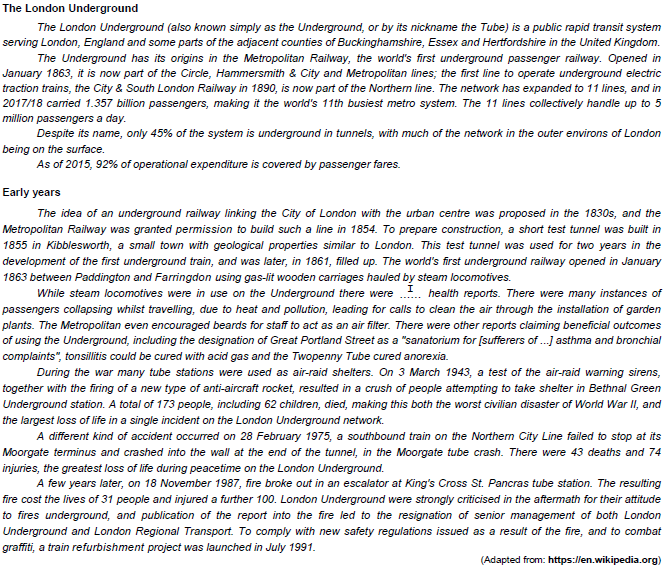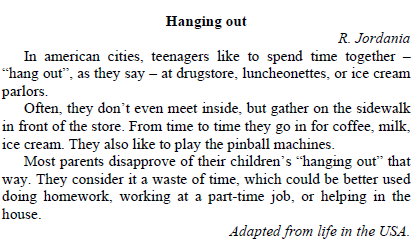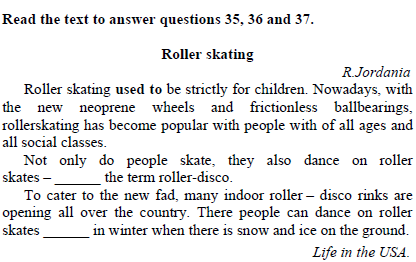“The students (30 energetic Italian pupils aged 15) have studied the passive forms with their usual English teacher. They can do written exercises to transform active to passive and vice versa and can construct passive sentences and questions (at least in theory). Now I, the conversation teacher, have been asked to practise the passive orally in my next 50 minute lesson."
The text above offers some advices for:
Leia as afirmativas a seguir:
I. Está correta a grafia do trecho a seguir: to read about (ler a respeito de).
II. À luz dos Parâmetros Curriculares Nacionais, a avaliação é parte integrante e intrínseca do processo educacional.
Marque a alternativa CORRETA:
Text for the item.
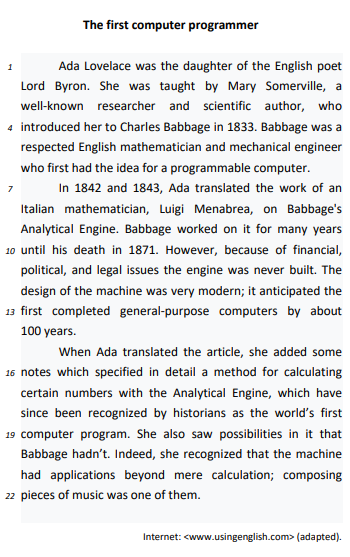
Based on the text, judge the items below.
Mary Somerville was Ada Lovelace's teacher
The following text is for question.
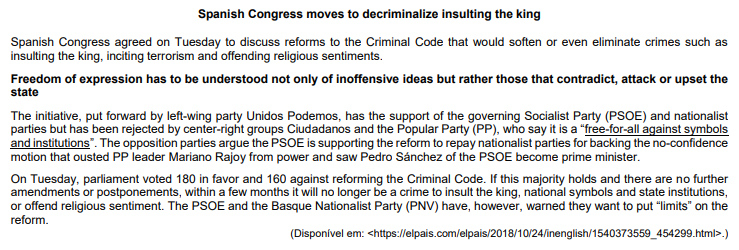
De acordo com o texto, é correto afirmar:
The following text is for question.

De acordo com o texto, espera-se que Chris Watts:
The following text is for question.

The text above tells the story of:
Text for the item.

Based on the text, judge the items below. Lack of money was the main reason why the building of the Analytical Engine was not carried out.
INSTRUCTIONS: Read the text carefully and then mark the alternatives that answer the question or complete the sentences presented after it.
TEXT I
Using authentic reading materials in FLT
Let us discuss what reading in a foreign language is, how it differs from reading in one’s mother-tongue. If the foreign language learners are poor readers in their mother-tongue, we can’t expect them to read efficiently in the foreign language. But if they are good readers in
their mother-tongue, we expect them to transfer their reading strategies to the foreign language automatically. Unfortunately, this doesn’t always happen. Automatic transfer of reading strategies from L1 to L2 is difficult or never occurs. Good readers use top-down and bottom-up strategies to make predictions about the meaning of the text and check them. They vary their reading speed and strategies according to the purpose for their reading and the type of the text. When the same students read a text in the foreign language, they tend to use bottom-up strategies, i.e. their linguistic knowledge, but they rarely dare to use top-down strategies, i.e. their knowledge about the world. Appropriate reading strategies are rarely used and even some faulty reading habits, e.g. subvocalizing, regressive eye movements, etc., can be observed. So, foreign language students usually need more reading practice in order to become efficient readers in the foreign language. The use of authentic materials is an important principle of Communicative Language Teaching. In real life we read because we are interested in the communicative purpose of the text, in the ideas that the writer has expressed or the effect that the text is supposed to produce on the reader. The language in an authentic text is varied, whereas in a non-authentic one there is often one single structure that is repeated. The use of truly authentic texts is an important means of teaching students to communicate effectively.
Unfortunately, most textbooks make use of non-authentic texts. They are supposed to be easier than authentic ones and to be better suited to the students’ language proficiency level. However, this is not true because:
- non-authentic texts are usually over-explicit: they say too much because they lack the natural redundancy of authentic ones, they abound with details, so, the students are not given the chance to make any inferences;
- textbook reading materials usually deal with over-familiar topics. This can hardly be avoided at beginner level but at the higher levels the reading texts can be more informative, enjoyable and interesting;
- there is often a noticeable emphasis on the product of the activity, i.e. on the answers to the comprehension questions, over the process, i.e. the appropriate use of reading skills and strategies in order to understand the text.
We can overcome these shortcomings quite successfully if we provide supplementary authentic texts. Thus the language learners will become better readers, confident in their ability to cope with reading in real life situations.
So, why do we read? In our daily lives we read for two basic reasons: for pleasure and for information (Grellet, 1981:4). We read for information because we want to find out something, to learn something from the text, or for instruction, in order to do something with the information we get, to find out how to act. These reasons for reading are authentic. […]
Having mentioned the major drawbacks of textbook reading materials, let’s now consider the guidelines for selecting a text to supplement them or even replace them. These are the readability, the suitability of content and the exploitability of the authentic text (Nuttal, 1982:25).
- Readability means that the text should be at the right level. When we try to find a readable text, we have to assess the level of its structural and lexical difficulty. Still, we should not forget that the students can deal with more difficult texts, provided the task is not too difficult.
- Suitability of content means that the text should be interesting and informative. The students’ preferences should not be neglected and a survey of their tastes might help the teacher quite a lot.
- Exploitability means that the text should facilitate the development of reading skills in order to help the students become competent and independent readers.
However, we shouldn’t forget the fact that language classes are not entirely homogeneous: the level of the students is not the same, their tastes may vary and it is virtually impossible to create an ideal reader who could tackle all existing texts successfully. So, our goals and
criteria should be realistic.
[…]
What should be pointed out in conclusion is the vital importance of using authentic texts as supplements to textbook reading materials in order to prepare students for real life reading. Authentic texts foster the development of their reading skills thus helping them gain confidence in their reading ability in the foreign language. They become autonomous readers, who can take responsibility for their own reading.
Available at: <https://www.beta-iatefl.org/1106/blogpublications>.Accessed on: July 9th, 2019. (Adapted).
According to the text, the strategies used by readers vary
INSTRUCTIONS: Read the text carefully and then mark the alternatives that answer the question or complete the sentences presented after it.
TEXT I
Using authentic reading materials in FLT
Let us discuss what reading in a foreign language is, how it differs from reading in one’s mother-tongue. If the foreign language learners are poor readers in their mother-tongue, we can’t expect them to read efficiently in the foreign language. But if they are good readers in
their mother-tongue, we expect them to transfer their reading strategies to the foreign language automatically. Unfortunately, this doesn’t always happen. Automatic transfer of reading strategies from L1 to L2 is difficult or never occurs. Good readers use top-down and bottom-up strategies to make predictions about the meaning of the text and check them. They vary their reading speed and strategies according to the purpose for their reading and the type of the text. When the same students read a text in the foreign language, they tend to use bottom-up strategies, i.e. their linguistic knowledge, but they rarely dare to use top-down strategies, i.e. their knowledge about the world. Appropriate reading strategies are rarely used and even some faulty reading habits, e.g. subvocalizing, regressive eye movements, etc., can be observed. So, foreign language students usually need more reading practice in order to become efficient readers in the foreign language. The use of authentic materials is an important principle of Communicative Language Teaching. In real life we read because we are interested in the communicative purpose of the text, in the ideas that the writer has expressed or the effect that the text is supposed to produce on the reader. The language in an authentic text is varied, whereas in a non-authentic one there is often one single structure that is repeated. The use of truly authentic texts is an important means of teaching students to communicate effectively.
Unfortunately, most textbooks make use of non-authentic texts. They are supposed to be easier than authentic ones and to be better suited to the students’ language proficiency level. However, this is not true because:
- non-authentic texts are usually over-explicit: they say too much because they lack the natural redundancy of authentic ones, they abound with details, so, the students are not given the chance to make any inferences;
- textbook reading materials usually deal with over-familiar topics. This can hardly be avoided at beginner level but at the higher levels the reading texts can be more informative, enjoyable and interesting;
- there is often a noticeable emphasis on the product of the activity, i.e. on the answers to the comprehension questions, over the process, i.e. the appropriate use of reading skills and strategies in order to understand the text.
We can overcome these shortcomings quite successfully if we provide supplementary authentic texts. Thus the language learners will become better readers, confident in their ability to cope with reading in real life situations.
So, why do we read? In our daily lives we read for two basic reasons: for pleasure and for information (Grellet, 1981:4). We read for information because we want to find out something, to learn something from the text, or for instruction, in order to do something with the information we get, to find out how to act. These reasons for reading are authentic. […]
Having mentioned the major drawbacks of textbook reading materials, let’s now consider the guidelines for selecting a text to supplement them or even replace them. These are the readability, the suitability of content and the exploitability of the authentic text (Nuttal, 1982:25).
- Readability means that the text should be at the right level. When we try to find a readable text, we have to assess the level of its structural and lexical difficulty. Still, we should not forget that the students can deal with more difficult texts, provided the task is not too difficult.
- Suitability of content means that the text should be interesting and informative. The students’ preferences should not be neglected and a survey of their tastes might help the teacher quite a lot.
- Exploitability means that the text should facilitate the development of reading skills in order to help the students become competent and independent readers.
However, we shouldn’t forget the fact that language classes are not entirely homogeneous: the level of the students is not the same, their tastes may vary and it is virtually impossible to create an ideal reader who could tackle all existing texts successfully. So, our goals and
criteria should be realistic.
[…]
What should be pointed out in conclusion is the vital importance of using authentic texts as supplements to textbook reading materials in order to prepare students for real life reading. Authentic texts foster the development of their reading skills thus helping them gain confidence in their reading ability in the foreign language. They become autonomous readers, who can take responsibility for their own reading.
Available at: <https://www.beta-iatefl.org/1106/blogpublications>.Accessed on: July 9th, 2019. (Adapted).
According to Nuttal (mentioned in the text), the selection of authentic reading material should consider some guidelines, as presented below. Mark the alternative that is not included as an item.
INSTRUCTIONS: Read the text carefully and then mark the alternatives that answer the question or complete the sentences presented after it.
TEXT II
Reading approaches language practices which come directly from the interaction of the reader with the written text, especially under the focus of the constitution of meaning, based on understanding and interpreting genres written in the English language, which circulate in the
various fields and layers of society. The practice of reading in English promotes, for example, the development of strategies of textual recognition (the use of verbal and non-verbal clues into the formulation of hypotheses and inferences) and of the investigation of the ways in which the contexts in the BNCC facilitate processes of meaning and critical reflection of the themes under study.
The work with verbal and hybrid genres, mainly potentialized by digital media, makes it possible to live, in a meaningful and pre-given way, diverse ways of reading (reading in order to have a general idea of the text, search for specific information, understand details, etc.), as well as different aims at reading (in order to do research, or enhance one’s own writing, read aloud to defend ideas or arguments, to act in the actual world, always in a critical manner, among other aims). Besides, reading practices in English include diverse possibilities of contexts in the use of languages for research and enhancing of knowledge of meaningful themes for the students, in interdisciplinary works or esthetic appreciation of genres like poems, plays, etc.
Reading from chosen texts, involving practice with diverse written and multimodal texts, of great importance to the life of students in their school, social and cultural aspects, as well as the analyzing and problematizing of the chosen texts, help develop critical reading and the
building of an autonomous and creative trajectory in language learning.
BRASIL. Base Nacional Comum Curricular (BNCC). Available at: <http://basenacionalcomum.mec.gov.br/>. Acessed on: August 31th, 2019 (Free translation).
Among other advantages in the learning process, reading
Text 2: Benefits of exercise

INSTRUCTIONS: Read the text and answer the question that follow it
According to the information in the first paragraph,


